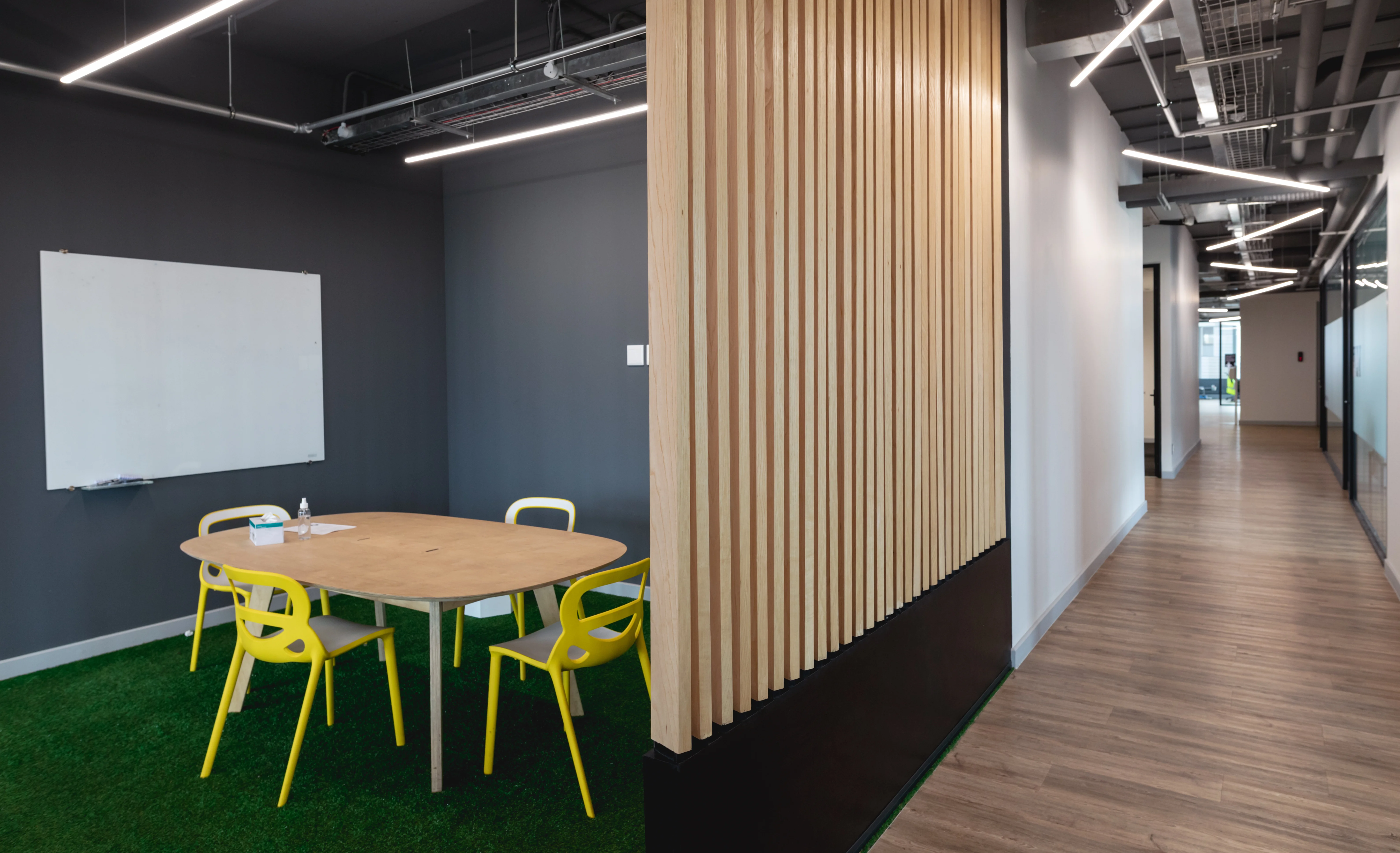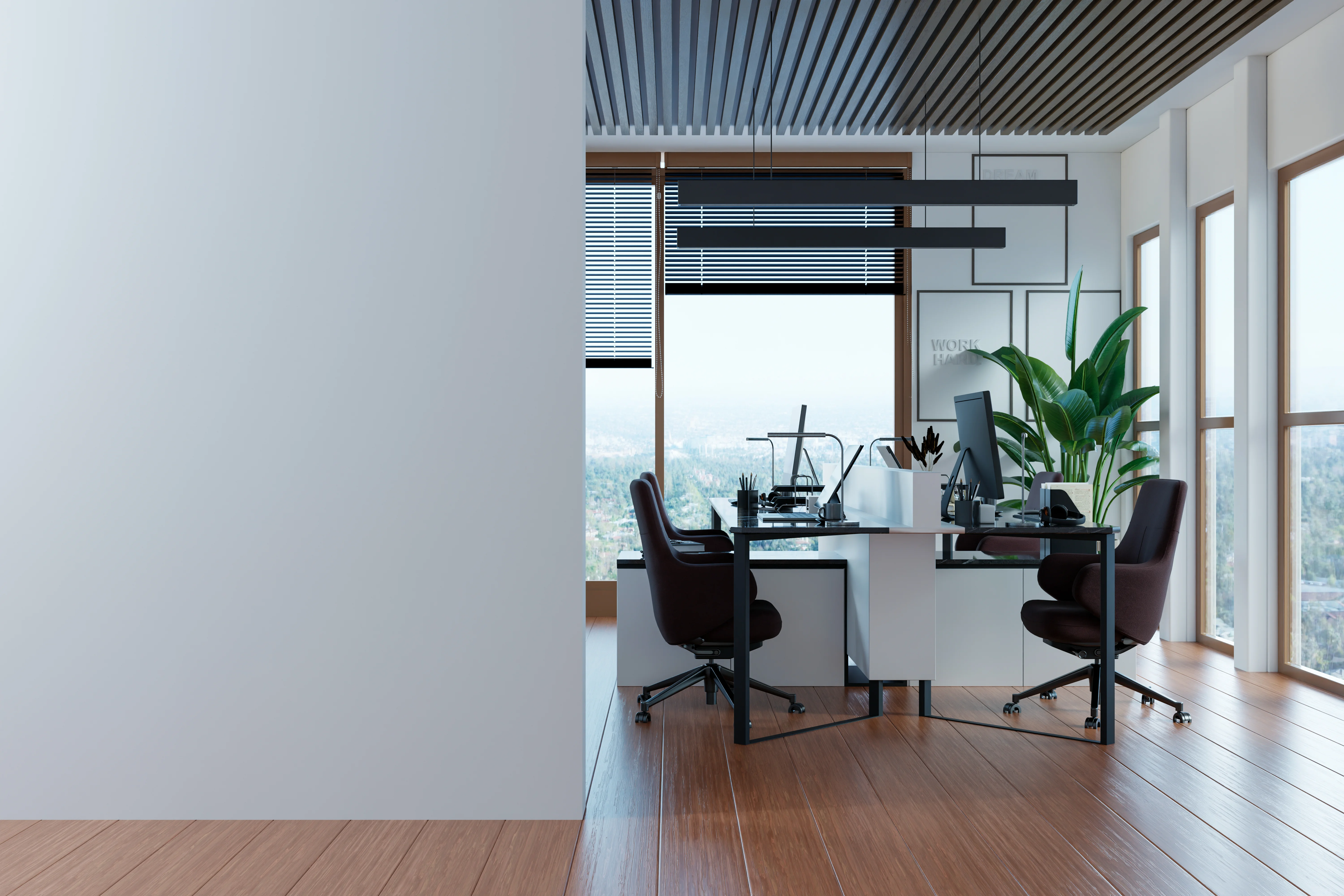AI tools provide insights into workplace design trends. They help create spaces that boost productivity and employee satisfaction. Office space planning software powered by AI is a game-changer. It allows for better space utilization and design flexibility. Commercial office interior design is evolving with AI. It creates adaptive and flexible workspaces that meet modern needs.
AI design tools offer innovative solutions for collaborative workspace design. They foster teamwork and innovation in the office. This guide explores how AI is transforming office design. Discover the tools, trends, and applications shaping modern workspaces.
The Rise of AI in Office Interior Design
Artificial intelligence is becoming central to office interior design. It provides automation and deep insights that were once hard to achieve. AI tools are reshaping how designers approach commercial office interior design. They allow for smarter decision-making and quicker turnarounds.
With AI, office design becomes more data-driven. Designers can now analyze big data to predict design trends and requirements. This tech also helps to personalize office environments. AI ensures that spaces align with company culture and brand identities.
Key Benefits of AI in Office Design
- Enhanced productivity through optimized layouts
- Efficient use of office space and resources
- Personalized environments for unique business needs
AI-powered tools can simulate different design scenarios. This feature helps in selecting the best office building design choices. Moreover, AI helps create adaptive spaces that evolve with business needs. The flexibility offered by AI ensures long-term viability. A major shift is how AI incorporates ergonomic principles. This focus helps in designing healthier work environments.
AI technology supports sustainable office designs. It optimizes energy use, making offices more eco-friendly and cost-efficient. The rise of AI in office design is just the beginning. As technology advances, expect even greater innovations in workspace design. AI is set to redefine how offices are designed and used, moving towards smarter, more effective solutions that cater to the demands of modern work life.
.webp)
How AI Transforms Office Floor Plan Design
AI is revolutionizing office floor plan design, bringing efficiency and precision. Traditional methods involved extensive manual work and guesswork, often leading to inefficiencies. Using AI, designers can now rely on powerful algorithms. These algorithms generate optimized floor plans quickly. This transformation saves both time and costs.
AI tools evaluate countless design options. They analyze and suggest layouts that maximize space utilization. This approach ensures every square foot is used effectively.
Here are key ways AI impacts floor plan design:
- Automated layout generation: AI creates multiple design options in minutes.
- Data-driven insights: AI analyzes patterns for optimal space usage.
- Flexibility: Allows quick adjustments based on new requirements.
AI's predictive capabilities enhance design foresight. It helps in forecasting future workspace needs, adapting layouts accordingly. Moreover, AI considers employee movement and interaction patterns. This information helps in crafting collaborative spaces that enhance productivity. AI also integrates ergonomic elements into floor plans. It promotes well-being by making workspaces more comfortable and efficient.
AI tools contribute to sustainability. They propose designs that reduce energy consumption and support eco-friendly building operations. Incorporating AI into floor plan design leads to better workplace experiences. It creates environments that inspire innovation and collaboration. AI’s transformative power in office floor planning signifies a shift towards more intelligent, responsive workspaces. Expect further advancements as AI technology continues to evolve.
AI-Powered Office Space Planning Software: Features and Benefits
Office space planning software powered by AI is a game-changer. It equips managers and designers with intelligent tools to optimize office layouts. This software analyzes vast amounts of data. This capability leads to insightful decisions that enhance space utilization. As a result, companies can achieve an ideal balance between open and private work areas.
Features of AI-Powered Planning Software:
- Real-time simulations: Visualize how changes affect the entire office layout.
- Predictive analytics: Anticipate future needs based on current trends and data.
- Customization: Tailor spaces to meet specific organizational goals and aesthetics.
This software enables collaboration among design teams. By integrating AI solutions, different departments can contribute insights. This cooperative approach encourages creativity and innovation. Additionally, AI software includes sustainability features. It offers strategies to minimize energy consumption and support green initiatives. Companies can create eco-conscious spaces without compromising on design.
AI planning tools also enhance employee comfort and productivity. They help create ergonomic environments tailored to user needs. By improving well-being, companies can boost morale and job satisfaction. The adaptability of AI-powered software allows businesses to respond to changes rapidly. Whether expanding or reorganizing, companies can efficiently adapt to new spatial demands. This software is not only a tool but a strategic asset. It aligns office space with corporate goals. Organizations can foster a culture that supports growth and innovation.
AI in office space planning is indispensable in modern workspace management. It provides versatile solutions that meet today's dynamic business environments.
Workplace Design Trends Driven by AI
AI is at the forefront of workplace design trends. It offers insights that transform traditional offices into modern work environments. By examining patterns and preferences, AI reveals what works best. These trends focus on flexibility and adaptability. Companies now favor spaces that can easily accommodate changes in team dynamics or organizational structure.
Trends Influenced by AI:
- Biophilic design: Integrating natural elements to promote wellness.
- Smart spaces: Using sensors and IoT to enhance functionality.
- Dynamic layouts: Movable furniture for versatile arrangements.
- Personalized environments: Tailoring spaces to individual user needs.
- Hybrid workspaces: Supporting both remote and in-office work styles.
AI-driven trends are reshaping how offices look and function. They emphasize the importance of employee experience, recognizing it as crucial to success. Companies now seek to create environments that cater to varied workstyles. Innovation spurred by AI fosters creativity and collaboration. By breaking down conventional barriers, spaces become more inclusive and engaging. Employees benefit from environments that accommodate diverse needs and preferences.
Incorporating AI trends requires a forward-thinking approach. Design decisions should align with long-term goals and company values. As technology evolves, staying ahead demands a commitment to continuous improvement.

AI Tools for Commercial Office Interior Design
AI tools are reshaping commercial office interior design. These technologies simplify and enhance the design process, making it more efficient. With AI, designers can explore numerous options quickly. They can generate multiple design scenarios to find the best fit.
AI-assisted tools offer data-driven insights. They help in optimizing layouts for better space utilization and employee productivity. These tools consider factors such as lighting, acoustics, and ergonomics.
Benefits of AI Tools:
- Faster prototyping: Create designs more rapidly.
- Accurate simulations: Test different configurations virtually.
- Design personalization: Tailor spaces to brand identity.
- Resource efficiency: Optimize materials and furnishings.
- Trend analysis: Stay ahead of design trends.
AI tools also support collaboration among stakeholders. By providing virtual models, they ensure everyone is aligned with the vision. This technology minimizes guesswork, allowing designers to focus on creativity. The result is offices that meet both aesthetic and functional requirements.
AI is transforming how offices are designed, making them more adaptive and future-proof. These innovations not only reduce costs but also enhance the quality of work environments. As AI continues to evolve, commercial interiors will become even more dynamic and responsive.
Collaborative Workspace Design with AI
Collaborative workspaces are vital in today’s dynamic work environment. AI technology plays a crucial role in enhancing these spaces. AI helps designers create layouts that foster teamwork and innovation. It analyzes employee interactions and movement patterns to optimize space design. This ensures that spaces are conducive to collaboration. By integrating AI, companies can adapt spaces to changing needs. AI-powered tools suggest configurations that balance open and private work areas. This flexibility is key in maintaining productivity and engagement.
AI’s Role in Collaborative Workspace Design:
- Behavioral analysis: Understand employee collaboration patterns.
- Real-time adaptation: Adjust layouts for specific tasks.
- Space optimization: Maximize usable areas for group activities.
- Inclusive design: Cater to diverse work styles.
AI also helps in integrating technology into physical spaces seamlessly. Smart meeting rooms and digital collaboration tools can be incorporated within the design. This creates an environment that supports both in-person and remote teamwork.
AI-driven designs encourage spontaneous interactions, leading to creative breakthroughs. By providing the right mix of spaces, AI ensures that offices nurture a sense of community. As workplace dynamics evolve, AI will continue to play a pivotal role in designing collaborative work environments that are both functional and inspiring.
Office Ergonomics and Layout Optimization Using AI
Ergonomics is essential for creating healthy workplaces. AI is revolutionizing how offices optimize ergonomic layouts for employee well-being.
AI analyzes vast datasets, considering posture, movement, and fatigue factors. This data-driven approach ensures designs that reduce strain and promote comfort. AI tools provide real-time feedback to adjust layouts for ergonomic benefits.
Ergonomic-focused AI solutions often incorporate adjustable furniture recommendations. They suggest seating arrangements that minimize physical stress. Also, lighting and acoustics are optimized for a healthier work environment.
AI in Ergonomic Office Design:
- Posture analysis: Identify optimal seating positions.
- Adjustable solutions: Recommend height-adjustable desks.
- Environmental factors: Optimize lighting and noise levels.
- Movement patterns: Encourage adequate physical activity.
AI-driven ergonomic designs boost productivity and job satisfaction. By minimizing discomfort, employees can focus better on their tasks. AI also addresses accessibility needs, ensuring inclusive designs for everyone.
These intelligent systems continuously learn and update, adapting to individual employee needs over time. As AI technology evolves, its role in ergonomic office design will further enhance workplace health and efficiency. By prioritizing ergonomic principles, companies create environments where employees thrive, leading to long-term business success.

Contemporary Office Design Ideas Enhanced by AI
Modern office design is constantly evolving. AI brings innovative ideas to the forefront, reshaping how offices look and function. Through AI, designers can tap into trends that merge aesthetics with functionality. AI analyzes extensive design data and trends, providing insights into what's effective. It identifies which colors, materials, and layouts are most engaging and productive. This leads to designs that are not only visually appealing but also enhance user experience.
AI-generated simulations help designers visualize space utilization effectively. By predicting user interactions, spaces can be crafted to encourage collaboration, creativity, and innovation.
Key AI-driven Office Design Ideas:
- Dynamic layouts: Spaces that adapt to usage needs.
- Biophilic elements: Incorporating nature for a calming environment.
- Flexible designs: Modular furniture for adjustable setups.
AI tools assist designers in personalizing office spaces to reflect company culture. They highlight brand identity through unique and customized layouts that resonate with employees. This personalization fosters a sense of pride and belonging among staff.
By embedding AI in the design process, companies can stay ahead of trends. AI offers cutting-edge solutions, ensuring contemporary office spaces are always at the forefront of design innovation. As AI technologies advance, these design ideas will continue to evolve, redefining modern office aesthetics.
Small Commercial Building Design: AI Solutions for Limited Spaces
Designing small commercial spaces presents unique challenges. AI offers practical solutions to optimize space usage and functionality. These tools maximize every square foot, ensuring no space is wasted.
AI technologies analyze spatial data to suggest efficient layouts. They consider factors like natural light, traffic flow, and user needs. By optimizing these elements, AI helps create cohesive and functional environments.
AI-driven tools enable rapid prototyping of multiple layout scenarios. This flexibility allows designers to experiment and find the best configurations for each space. The result is a layout that feels spacious, even in compact areas.
AI Benefits for Small Spaces:
- Space optimization: Efficient use of all available areas.
- Cost efficiency: Reducing design and construction expenses.
- Adaptive designs: Flexible layouts that can evolve with needs.
Through smart space planning, AI helps small businesses create attractive and functional workspaces. It ensures that these spaces reflect the brand's identity and meet operational needs. As AI continues to evolve, it will further improve small space design, making it more versatile and accommodating.
AI Floor Plan Generators: How They Work and What to Expect
AI floor plan generators revolutionize the way we design spaces. These advanced tools automate the tedious task of drafting floor plans. By leveraging machine learning algorithms, they can quickly create optimized layouts tailored to specific needs.
Users input basic parameters, such as room size and purpose. The AI then processes this data, considering aspects like flow, accessibility, and light. Within moments, it generates multiple design options to explore.
This technology reduces both time and effort in the design process. AI floor plan generators are capable of handling complex variables. They can align designs with ergonomic standards, company culture, or sustainability goals.
Advantages of AI Floor Plan Generators:
- Efficiency: Faster design iterations.
- Customization: Personalized layouts matching client requirements.
- Data-driven insights: Designs based on comprehensive analysis.
With these tools, designers gain the ability to visualize potential layouts more effectively. They provide a foundation for creative, informed decision-making, elevating the quality and efficiency of the design process. As AI evolves, these generators will become even more sophisticated, offering deeper customization and smarter design solutions.
.webp)
Integrating AI Design Tools with Existing Office Layout Design Tools
Integrating AI with traditional office layout tools unlocks new capabilities. This combination streamlines design processes by merging innovation with familiar methods. Designers benefit from both AI-driven insights and reliable design frameworks.
Existing tools focus on fundamental layout creation. By adding AI, users enhance these capabilities with predictive analytics and automated suggestions. This integration supports quick adjustments to the designs, accommodating dynamic office needs.
Benefits of Integration:
- Enhanced capabilities: Combines strengths of both AI and traditional tools.
- Real-time updates: Streamlines updates based on changing requirements.
- Improved precision: Offers data-backed design decisions.
Successful integration requires compatibility between platforms. Users should prioritize tools that facilitate seamless data exchange. As AI technology evolves, its integration will continually improve, offering more sophisticated design options and a greater degree of customization. This synergy empowers designers to craft innovative, efficient, and adaptable office layouts that are future-ready.
Sustainability and Green Office Building Design with AI
AI plays a crucial role in promoting sustainable office design. It aids in minimizing environmental impact through smart energy management. AI systems analyze data to optimize energy consumption and reduce waste.
This approach aligns well with green building standards. AI can help ensure designs meet certifications like LEED. By automating resource management, AI supports sustainable practices and enhances operational efficiency.
AI Contributions to Green Design:
- Energy efficiency: Smart management and optimization.
- Resource conservation: Data-driven reduction of waste.
- Sustainability goals: Alignment with environmental certifications.
Designers can utilize AI to select eco-friendly materials and employ renewable energy solutions. These improvements lead to healthier workspaces. AI empowers organizations to meet their sustainability goals while creating comfortable, efficient, and environmentally friendly office environments. With technology advancing, AI's role in fostering sustainability is expected to grow, offering innovative solutions for green building design.
The Future of AI Office Design: What’s Next?
AI is set to redefine future office designs. It will drive more personalized and adaptive spaces. Expect enhanced integration of technology in everyday work environments. AI advancements may soon offer real-time design modifications. With new technologies, office spaces can evolve instantly to meet changing needs. This adaptability will become a cornerstone of office design strategies.
Predicted Future Developments:
- Real-time design changes: Instant adaptability.
- Enhanced personalization: Custom solutions for each workplace.
- Seamless tech integration: Smart and interconnected offices.
Workplaces will become more intuitive and responsive. Future AI tools are likely to understand employee preferences and habits, further optimizing layouts and designs. As AI continues to advance, office designs will become more in tune with human needs, paving the way for smarter, more efficient, and dynamic workspaces.
.webp)
Key Takeaways and Best Practices for AI Design in Offices
Embracing AI in office design is a strategic move. It offers efficiency, flexibility, and innovation. AI tools can streamline the design process and optimize space utilization.
To make the most of AI, focus on integrating it with your existing design processes. Leverage AI tools that align with your office goals. It's crucial to balance tech capabilities with human-centric needs.
Best Practices:
- Align AI with business objectives: Ensure AI solutions support your company's goals.
- Foster collaboration: Encourage feedback between AI tools and human designers.
- Prioritize employee well-being: Incorporate ergonomics and design for wellness.
- Adopt a flexible approach: Utilize AI for adaptable, future-ready spaces.
Keep an eye on emerging AI trends. Staying informed ensures your office remains at the forefront of design innovation. With thoughtful implementation, AI can transform workplaces into more productive and inspiring environments.
From Floor Plans to Interiors: qbiq Delivers Interior Design for Offices
AI can make the process of achieving a modern, effective workspace efficient and predictable. With better tools and approaches, it is easier than ever to achieve beautifully designed offices that inspire employees and communicate company culture without high costs and drawn-out iterations.
Thanks to advanced automated architectural capabilities, qbiq is able to deliver more than floor plans. It is able to easily produce viable designs with visually compelling design concepts that match modern workspace needs. Whether it’s an open collaborative hub or a private executive suite, qbiq instantly provides multiple design variations so decision-makers can compare and refine options.
In our case study with a Fortune 500 client, qbiq helped create design concepts across global offices with consistent brand identity, all while cutting design lead time by more than 70 percent. This ability to pair functional layouts with design inspiration ensures that companies achieve both style and substance in their offices.
Book a demo today to explore how qbiq can bring your office interiors to life.
Frequently Asked Questions About AI Design for Offices
AI in interior design for offices might raise questions. Understanding its capabilities can ease concerns. Many wonder how AI impacts design quality and creativity.
One common question is about the cost of AI implementation. Initial costs may seem high, but long-term savings on design mistakes and energy efficiency can offset these. Another concern is the role of human designers in AI-driven projects. AI enhances creativity by managing tedious tasks, allowing designers to focus on innovation.
FAQs:
- How does AI affect design creativity?
- AI takes care of repetitive tasks, freeing designers to explore creative solutions.
- Is AI expensive to implement?
- While initial costs may be higher, AI can lead to long-term savings.
- Will AI replace human designers?
- No, AI supports and enhances their work, improving efficiency and outcomes.







.png)









